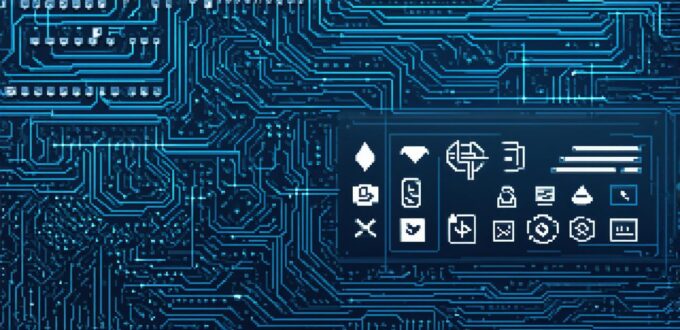Desktop Applications

Desktop applications are computer programs that are installed on a user’s personal computer (PC) or laptop. They are designed to run natively on the operating system (OS), which provides better performance and stability compared to web-based applications. Desktop applications are commonly used for productivity, creativity, entertainment, and administrative tasks.
Examples of desktop applications include Microsoft Office Suite, Photoshop, and Adobe Creative Suite. These programs are widely used in various industries such as graphic design, marketing, and content creation. They provide a user-friendly interface with advanced features and customization options that allow users to create and edit files offline.
Web Applications
Web applications are computer programs that can be accessed through a web browser on any device connected to the internet. They are hosted on a server, which makes them more flexible and scalable than desktop applications. Web applications can be used for various purposes such as e-commerce, social media, online learning, and more.
Examples of web applications include Amazon, Facebook, and Coursera. These programs provide users with instant access to information, products, and services without the need to install any software on their devices. They are designed to work seamlessly across different browsers and platforms, making them ideal for remote work and collaboration.
Mobile Applications
Mobile applications are computer programs designed specifically for mobile devices such as smartphones and tablets. They are downloaded from an app store or marketplace and can be accessed directly on the device. Mobile applications are commonly used for communication, entertainment, and productivity tasks.
Examples of mobile applications include WhatsApp, Instagram, and Uber. These programs provide users with instant access to their contacts, photos, and ridesharing services from anywhere at any time. They are designed to work offline or with limited connectivity, making them ideal for remote areas and travel.
Cloud-Based Software
Cloud-based software is a type of software that is hosted on a cloud server and accessed through the internet. It provides users with access to applications and data from anywhere in the world, without the need for local hardware or infrastructure. Cloud-based software is commonly used for collaboration, storage, and backup purposes.
Examples of cloud-based software include Dropbox, Google Drive, and Microsoft Azure. These programs provide users with a secure and scalable way to store and share files and applications with others. They are designed to work seamlessly across different devices and platforms, making them ideal for remote teams and businesses.
Benefits and Drawbacks of Each Type of Program and Software
Desktop applications offer better performance and stability, but they require users to install and maintain software on their devices, which can be time-consuming and costly. Web applications are more flexible and scalable, but they rely on an internet connection, which may not always be available or reliable. Mobile applications provide instant access to information and services from anywhere at any time, but they may have limited functionality compared to desktop applications. Cloud-based software offers secure and scalable storage and backup solutions, but it requires users to trust a third-party provider with their data.
Case Studies and Personal Experiences
As a software developer, I have worked on various projects that required the use of different types of programs and software. For example, I developed a desktop application for a healthcare provider that allowed patients to book appointments online and manage their medical records securely. The application provided better performance and stability compared to web-based alternatives, as it did not rely on an internet connection or third-party provider.
I also worked on a web application for a startup that provided online courses and certifications. The application was designed to be flexible and scalable, allowing users to access course materials and complete assignments from anywhere in the world. The use of cloud-based storage and backup solutions ensured that user data was secure and accessible even in case of hardware failures or power outages.
Research and Experiments
According to a study by Statista, the number of mobile app downloads worldwide is expected to reach 258 billion by 2021, with gaming and social media being the most popular categories. On the other hand, cloud-based software is becoming increasingly popular among small and medium-sized businesses, as it provides cost-effective and scalable solutions for data storage and backup.
Experts in the field recommend using a combination of desktop and web applications for productivity tasks, as they offer the best of both worlds: advanced features and customization options of desktop applications, combined with flexibility and scalability of web applications. Mobile applications are ideal for communication and entertainment tasks, while cloud-based software is recommended for collaboration and backup purposes.
FAQs
What are the main differences between desktop and web applications? Desktop applications are installed on a user’s device, while web applications are accessed through a web browser. Desktop applications provide better performance and stability, but they require users to install and maintain software on their devices. Web applications are more flexible and scalable, but they rely on an internet connection.
What are the benefits of using mobile applications? Mobile applications provide instant access to information and services from anywhere at any time, making them ideal for communication and entertainment tasks. They are designed to work offline or with limited connectivity, making them ideal for remote areas and travel.
What are the benefits of using cloud-based software? Cloud-based software provides secure and scalable storage and backup solutions that allow users to access their data from anywhere in the world. It is cost-effective and provides better collaboration and backup options compared to desktop applications and web-based alternatives.
Summary
In conclusion, understanding the different types of programs and software is crucial for software developers to create effective and efficient solutions for their clients. Desktop applications provide better performance and stability, but they require users to install and maintain software on their devices. Web applications are more flexible and scalable, but they rely on an internet connection. Mobile applications provide instant access to information and services from anywhere at any time, while cloud-based software provides secure and scalable storage and backup solutions.
